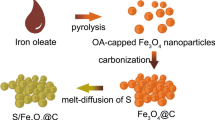Abstract
Lithium-sulfur batteries have attracted great attention due to their high capacity and energy density. However, sulfur cathode suffers from poor cycle stability during the electrochemical process. Fe3C materials are promising sulfur hosts for lithium-sulfur batteries due to their high catalytic effect. In this work, we present Fe3C nanoparticles combined with porous carbon as host materials for lithium-sulfur batteries to overcome these issues. In this hybrid structure, the presence of carbon could act as conductive network for the rapid transport of electrons and ions, while Fe3C could facilitate trapping lithium polysulfide due to its high catalytic effect. As a result, the Fe3C/C@S composites exhibit high specific capacity and stable cycle performance. This work provides a new and effective way for the sulfur host design of high performance lithium-sulfur batteries.





Similar content being viewed by others
References
Wen GY, Sui YL, Zhang XP, Li JP, Zhang ZW, Zhong SK, Tang SB, Wu L (2021) Mn3O4 anchored polypyrrole nanotubes as an efficient sulfur host for high performance lithium-sulfur batteries. J Colloid Interf Sci 589:208–216
Ma BQ, Gao YC, Niu MX, Luo M, Li HJ, Bai Y, Sun KN (2021) ZIF-67/Super P modified separator as an efficient polysulfide barrier for high-performance lithium-sulfur batteries. Solid State Ion 371:115750
Li YF, Chen MF, Zeng P, Liu H, Yu H, Luo ZG, Wang Y, Chang BB, Fe Wang XY (2021) Co-bimetallic doped C3N4 with in-situ derived carbon tube as sulfur host for anchoring and catalyzing polysulfides in lithium-sulfur battery. J Alloys Compd 873:159883
Zhang SL, Xu ZL, Jiang ZY, Xiao ZH, Tang AD, Yang HM (2022) The unique interconnected structure of hollow carbon skeleton doped by F and N facilitating rapid Li ions diffusion in lithium-sulfur batteries. Carbon 195:207–218
He YB, Chang Z, Wu SC, Zhou HS (2018) Effective strategies for long-cycle life lithium–sulfur batteries. J Mater Chem A 6:6155–6182
Wei AK, Wang L, Li Z (2022) Metal-organic framework derived binary-metal oxide/MXene composite as sulfur host for high-performance lithium-sulfur batteries. J Alloys Compd 899:163369
Liu FR, Wang N, Shi CS, Sha JW, Ma LY, Liu EZ, Zhao NQ (2022) Phosphorus doping of 3D structural MoS2 to promote catalytic activity for lithium-sulfur batteries. Chem Eng J 431:133923
Wei CB, Han YL, Liu H, Gan RH, Li QQ, Wang YL, Hu P, Ma C, Shi JL (2021) Advanced lithium–sulfur batteries enabled by a SnS2-Hollow carbon nanofibers flexible electrocatalytic membrane. Carbon 184:1–11
Long JW, Han TL, Zhu MF, Xu XY, Li JJ, Niu JJ, Liu JY (2021) A matryoshka-like CuS@void@Co3O4 double microcube-locked sulfur as cathode for high-performance lithium-sulfur batteries. Ceram Int 47:25769–25776
Huang S, Xiang E, Yang Y, Zhnag YF, Ye MH, Li CC (2021) Transition metal phosphides: new generation cathode host/separator modifier for Li–S batteries. J Mater Chem A 9:7458–7480
Liu KF, Zhao HB, Ye DX, Zhang JJ (2021) Recent progress in organic Polymers-Composited sulfur materials as cathodes for Lithium-Sulfur battery. Chem Eng J 417:129309
Li LB, Shan YH (2021) The use of graphene and its composites to suppress the shuttle effect in lithium-sulfur batteries. Carbon 179:702
Zhou L, Danilov DL, Qiao F, Eichel RA, Notten P (2022) ZnFe2O4 hollow rods enabling accelerated polysulfide conversion for advanced lithium-sulfur batteries. Electrochim Acta 414:140231
Deng SG, Shi XT, Zhao Y, Wang C, Wu JH, Yao XY (2022) Catalytic Mo2C decorated N-doped honeycomb-like carbon network for high stable lithium-sulfur batteries. Chem Eng J 433:133683
Sun CS, Guo DC, Shao QJ, Chen J (2021) Preparation of gelatin-derived nitrogen-doped large pore volume porous carbons as sulfur hosts for lithium-sulfur batteries. Carbon 177:430
Luo LY, Qin XY, Wu JX, Liang GM, Li Q, Liu M, Kang FY, Chen GH, Li BH (2018) An interwoven MoO3@CNT scaffold interlayer for high-performance lithium–sulfur batteries. J Mater Chem A 6:8612–8619
Xia G, Ye JJ, Zheng ZQ, Li XT, Chen CZ, Hu C (2021) Catalytic FeP decorated carbon black as a multifunctional conducting additive for high-performance lithium-sulfur batteries. Carbon 172:96–105
Zhang XM, Li GR, Zhang YG, Luo D, Yu AP, Wang X, Chen ZW (2021) Amorphizing metal-organic framework towards multifunctional polysulfide barrier for high-performance lithium-sulfur batteries. Nano Energy 86:106094
Yu LH, Ong SJ, Liu XH, Mandler D, Xu ZC (2021) The importance of the dissolution of polysulfides in lithium-sulfur batteries and a perspective on high-energy electrolyte/cathode design. Electrochim Acta 392:139013
Zhao ZY, Duan XB, Zhang L, Che ZW, Wang K, Zheng B, Wang XG (2021) Elevated electrochemical performances enabled by a core–shell titanium hydride coated separator in lithium–sulphur batteries. RSC Adv 11:30755–30762
Zhao S, Kang YJ, Liu MJ, Wen BH, Fang Q, Tang YY, He SC, Ma X, Liu MK, Yan Y (2021) Modulating the electronic structure of nanomaterials to enhance polysulfides confinement for advanced lithium–sulfur batteries. J Mater Chem A 9:18927–18946
Wang CL, Sun LS, Wang XX, Wang LM (2019) Spherical hybrid hierarchical porous structure: a plastic model with tunable inner pores for lithium-sulfur batteries. Carbon 153:691–698
Fahad S, Wei Z, Kushima A (2021) In-situ TEM observation of fast and stable reaction of lithium polysulfide infiltrated carbon composite and its application as a lithium sulfur battery electrode for improved cycle lifetime. J Power Sources 506:230175
Gao XG, Huang Y, Li X, Gao H, Li TH (2021) SnP0.94 nanodots confined carbon aerogel with porous hollow superstructures as an exceptional polysulfide electrocatalyst and “adsorption nest” to enable enhanced lithium-sulfur batteries. Chem Eng J 420:129724
Cheng DD, Zhao YL, Tang XW, An T, Wang X, Zhou H, Zhang D, Fan TX (2019) Densely integrated Co, N-Codoped Graphene@Carbon nanotube porous hybrids for high-performance lithium-sulfur batteries. Carbon 149:750–759
Author information
Authors and Affiliations
Corresponding author
Additional information
Publisher's note
Springer Nature remains neutral with regard to jurisdictional claims in published maps and institutional affiliations.
Supplementary Information
Below is the link to the electronic supplementary material.
Rights and permissions
About this article
Cite this article
Cai, Y. High catalytic Fe3C particles decorated porous carbon as stable cathodes for improved electrochemical performance. Ionics 28, 4363–4368 (2022). https://doi.org/10.1007/s11581-022-04670-9
Received:
Revised:
Accepted:
Published:
Issue Date:
DOI: https://doi.org/10.1007/s11581-022-04670-9




